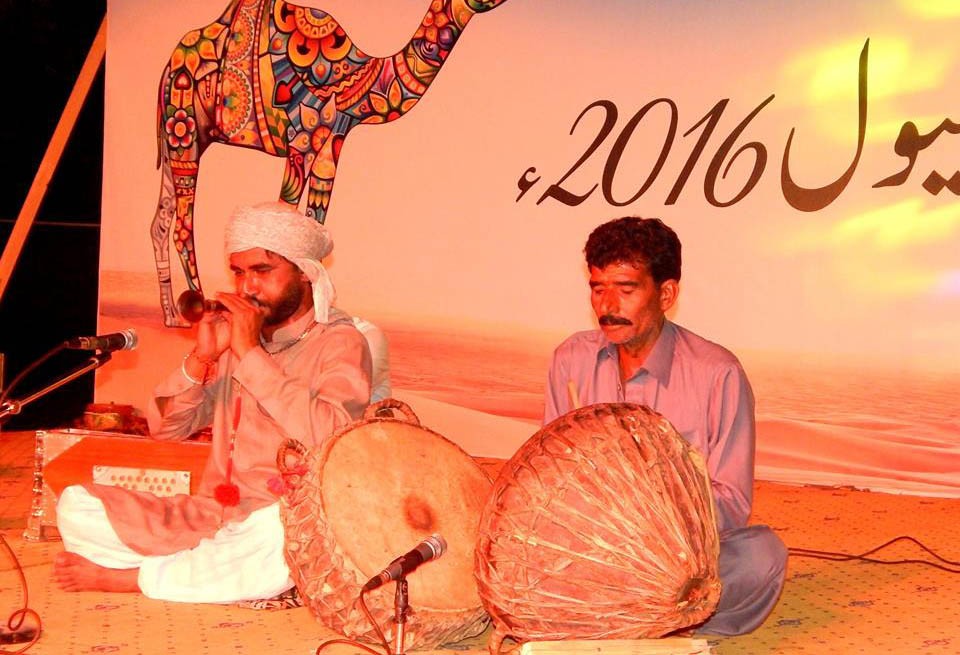
At Alhmara Lahore, a festival was held to celebrate the underdeveloped yet culturally rich Cholistan

To many, this debate about culture is a time warp. It implies glorification of a past that is static. A byword for permanence, and hence, backwardness in a binary as pitched against change and modernity.
Cholistan is one of the most economically backward areas of the country but not as culturally as was partly demonstrated by the Festival of Cholistan organised by the Cholistan Development Council of Pakistan at the Alhamra in Lahore last week.
Some societies may be very advanced in terms of the way they are structured, their systems very efficient and in sync with the latest technological developments but their artistic expression is not commensurate with these economic indicators. While some other societies may be very undeveloped and archaic, but still keep throwing up poets, painters and musicians with amazing regularity. The relationship between the two -- economic efficiency/ development and creativity in art -- is not very determined and based on variables which may be far too many to be taken into any rational reckoning.
In countries like Pakistan, the wish for homogeneity has been the driving force in all fields - be it politics, religion or culture. The embedded insecurity in the country has probably led to labelling all else as being traitorous to the unity in both political and cultural terms.
But in the last few years, another trend has emerged which celebrates the cultures of provinces. The Sindhis have been at the forefront celebrating their ajrak and topi as the two most vibrant or popular symbols of their culture. Similarly, other regions and provinces like Balochistan have followed suit and stressed on the peculiarities of their cultures.
Though not overt, this has an undercurrent of pinpointing the difference in cultures as opposed to the grand narrative of culture promoted by the state which many think is biased towards a monolithic Urdu/Punjabi reading of it. The regions have celebrated their diversity without provoking the ire of those that demand a more unified response in an almost militaristic way.
It has been rare that Punjabis have celebrated their culture in this distinct manner as a stand-out event because they have stood for national culture and, in the process, sacrificed their language, culture and customs in the run up to the bigger cause of the nation’s culture. If smaller provinces have resisted the dominance of the bigger province, the bigger province has looked askance at all this talk and discussion about diversity and escape from one dominant cultural strain.
But now Cholistan’s culture is being celebrated with the implication that it is different from the overarching Punjabi culture and in a way stressing that there is not one Punjabi culture, but many, definitely two if not more. There have been calls to separate seraiki language and culture from mainstream Punjabi language and culture.
Cholistan is home to Uch, one of the rare places in the Punjab which is rich in architecture and where the shrines of some of the most important Sufis are located. The Sultanate period architecture embodies the styles and motifs which link it to the splendid structures of Central Asia and Iran and establishes the connection with the later grand architecture of Northern India which now also includes Pakistan.
Cholistan has got peculiar architecture of its own as well which is exemplified in the Derawar Fort, the ancestral graveyard of the Nawabs of Bahawalpur and the adjacent mosque. And its vastness resonates with the poetry of Khawaja Ghulam Fareed, a representative poet of the area who employed the imagery of the desert landscape to create poetry which brings the entire local ethos to life. Pathanay Khan gave the poetry of Khawaja Fareed the musical soul that it yearned for.
One solid example of the culture of Cholistan is the existence of a large number of bhagats who sing the kalam of Sufi poets and a folk repertoire which is a reflection of a syncretic cultural tradition that can be traced back thousands of years. Bhagats like Megha Lal, Sanwar Lal Bheel and Bhagat Ram sing poetry that is a mixture of Sufi poetry and the text which is traditionally sung in the temples of the region. With their eiktaras, song and dance in their colourful attire, the various staging posts being either the shrines of poet’s priests or the various melas that occasionally dot the barren stretches of land.
One such mela is held at Channan Pir. With the blessings of Jalaluddin Surkh Bukhari in Jaisalmer a son was born to the Rani of Jaisalmer?. Fearing he would be a Muslim, the Raja ordered the newly born to be put to sword but the Rani. enthralled by motherhood, on the sly placed the baby in a cradle and dispatched it to the site where the present mazar is situated. The baby was very good-looking; many started calling him "channan" but it is also said that the cradle in which he was made to escape was made of sandalwood which in seraiki is called "channan" He grew up, his fame spread far and wide, and when he died, his shrine became famous for fulfilling the wish of those wanting a male child. It is a ritual that when the prayer is answered, and a son is born, the father dons women’s clothes like choli/ ghaggra and dances on the shrine for a few days, distributing alms all the while.
Being on the fringe, Cholistan has not been so badly hit by the mainstream development that has changed the urban and semi-urban areas of Punjab. Such festivals are usually held in the bigger cities or the capital to expose the urbanites to the culture and a way of life which very few have experienced directly, and have only read about or seen in the media.